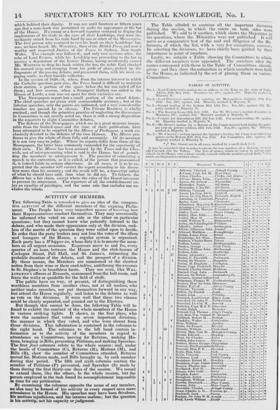ACTIVITY OF MEMBERS.
THE following Table is intended to give an idea of the compara- tive ACTIVITY of the different members of the expiring Parlia- ment. The People have very imperfect means of knowing how their Representatives conduct themselves. They may occasionally be informed who voted on one side or the other on particular questions ; but they cannot know who patiently listened to the debate, and who made their appearance only at the division, reck- less of the merits of the question they were called upon to decide. In order that the party leaders may not lose the votes of the idlers and loungers of the House, a regular system is organized. Each party has a Whipper-in, whose duty it is to muster the mem- bers on all urgent occasions. Expresses move to and fro, every quarter of an hour, between the House and the club-houses of Cockspur Street, Pall Mall, and St. James's, intimating the probable duration of the debate, and the prospect of a division. By these means, the Members are summoned at the shortest notice from their wine or their card-tables, and throng the avenues to St. Stephen's in breathless haste. They are even, like WEL- LINGTON'S officers at Brussels, summoned from the ball-room, and leave the waltz or quadrille for the field of strife.
The public have no way, at present, of distinguishing these worthless members from another class, not at all useless, who neither make speeches, nor put themselves forward in any way, but attend the House regularly, and listen to the debates as well as vote on the divisions. It were well that these two classes could be clearly separated, and pointed out to the Electors.
But though this cannot be done, the following Table will be found to exhibit the conduct of the whole members of the House in various striking lights. It shows, in the first place, who were the members that voted on seven important divisions, the manner in which they voted, and who were absent from Those divisions. This information is contained in the columns to the right hand. The columns to the left hand contain in- formation as to the activity of the members in regard to attendance on Committees, moving for Returns, making Mo-
tions, bringing in Bills, presenting Petitions, and making Speeches. The first four columns relate to the whole session: and, under the heads of Committees (C), Returns (R), Motions (M), and
Bills (B), show the number of Committees attended, Returns moved for, Motions made, and Bills brought in, by each member
during that period. The fifth and sixth columns contain the number of Petitions (P) presented, and Speeches (S) made by them during the first thirty-one days of the session. We meant to extend these, like the others, to the whole session, but the person employed in the task found its accomplishment impossible 4 in time for our publication. By examining the columns opposite the name of any member, an idea may be formed of his activity in every respect save mere attendance in the House. His speeches may have been frivolous, lus motions injudicious, and his returns useless; but the question is his activity, not his capacity or judgment The Table alluded to contains all the important divisions during the session, in which the voters on both sides were published. We add to it another, which shows the Majorities in six questions, where the Minorities were not published. It will serve as a comparative test of the zeal and diligence of the Re- formers, of which the list, with a very few exceptions, consists. In selecting the divisions, we have chiefly been guided by their importance in point of numbers. Lastly, we subjoin a Table showing the Committees to which the different members were appointed. The numbers after the names correspond with those in the Table of Committees already given : and they show the estimation in which members were held by the House, as indicated by the act of placing them on various Committees.


















































 Previous page
Previous page